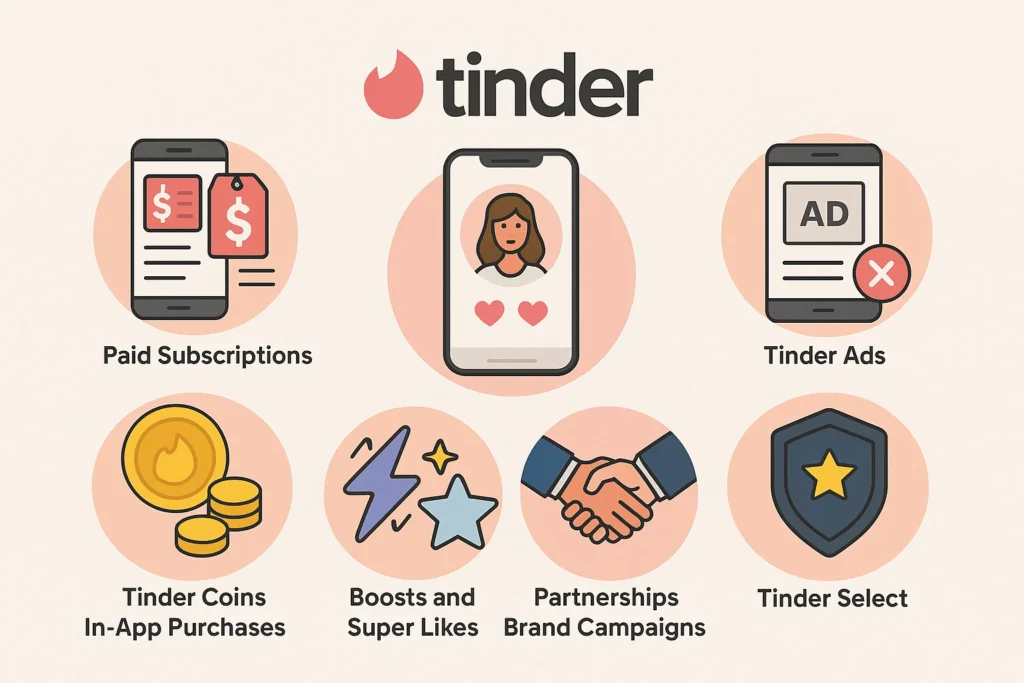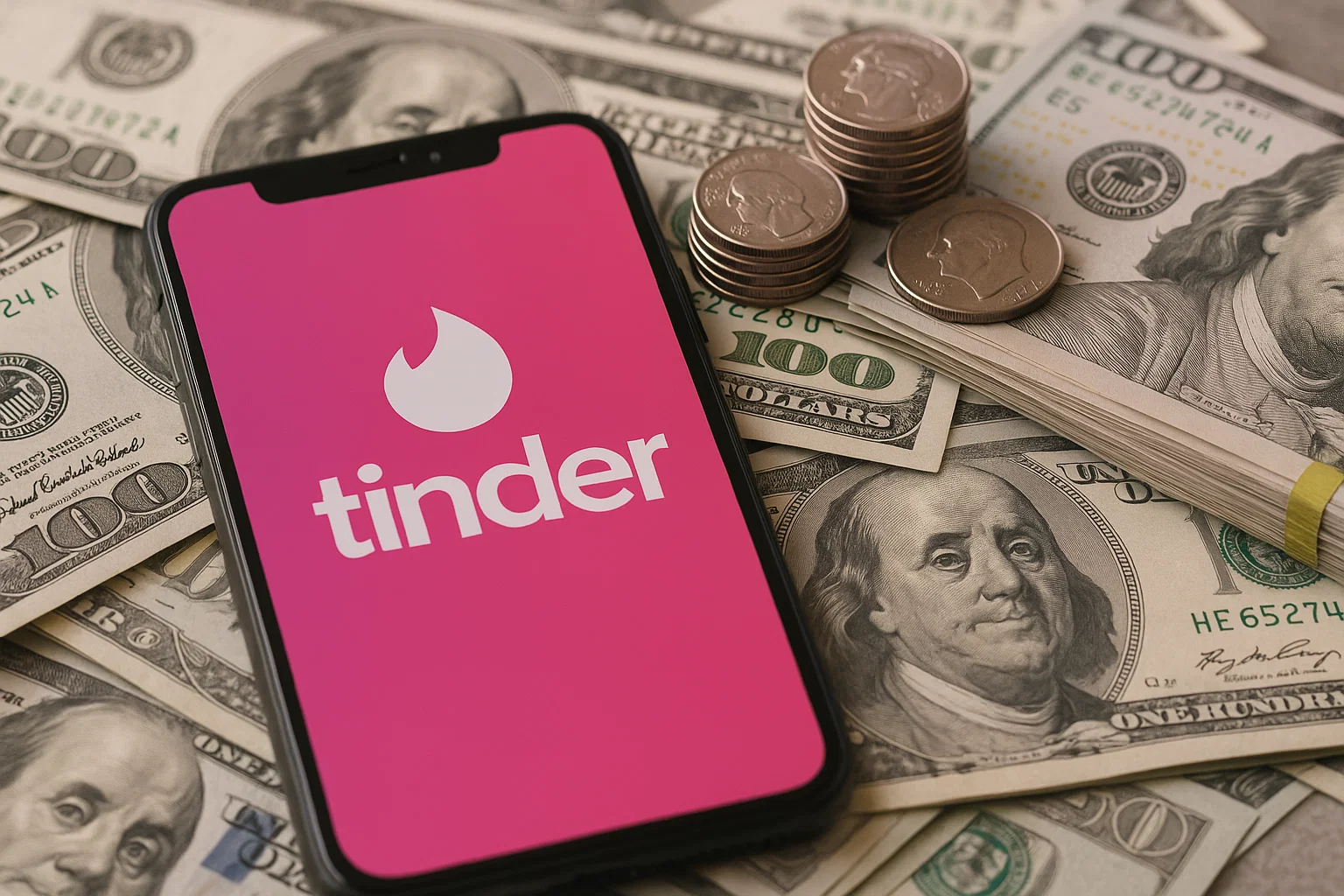Tinder isn’t just about swipes and matches — it’s a billion-dollar business powering one of the most successful monetization stories in the mobile app world. Launched in 2012, Tinder revolutionized online dating with its location-based, swipe-right interface and turned dating into a gamified experience.
Fast forward to 2025, Tinder boasts over 75 million monthly active users and has generated more than $1.8 billion in annual revenue. Its rise is a case study in how freemium apps can scale globally and monetize human connection.
In this blog, we’ll unpack how Tinder earns money, why its revenue model continues to work in 2025, and how startups can replicate its monetization strategy using a Tinder clone built by Miracuves.
How Tinder Makes Money
Tinder uses a freemium model with layered monetization — offering free access with optional upgrades that enhance visibility, engagement, and outcomes. Here’s how the app turns matches into millions:
- Tinder Plus, Gold, and Platinum Subscriptions – Monthly paid plans with added features like unlimited swipes, location change, top picks, and read receipts.
- Boosts and Super Likes – One-time paid features that increase visibility or help stand out to potential matches.
- Tinder Ads – In-app advertising shown to free users, monetized via programmatic and direct ad sales.
- Tinder Coins and In-App Purchases – A virtual currency for purchasing premium actions like Super Likes or Boosts.
- Partnerships and Brand Campaigns – Sponsored events, brand integrations, and collaborative promotions.
- Tinder Select – An exclusive invite-only tier for elite users, potentially paving the way for high-end monetization.

Together, these revenue streams turn casual users into paying customers and make Tinder one of the highest-grossing non-gaming apps worldwide.
From swipe-based matching to instant chats, Tinder redefined dating—explore the Tinder app features that made it iconic.
Detailed Breakdown of Revenue Channels
Tinder Plus, Gold, and Platinum Subscriptions
Tinder’s core revenue driver is its tiered subscription model:
- Tinder Plus offers basic upgrades like unlimited swipes, rewind (undo), and passport (location change).
- Tinder Gold adds features like seeing who liked you, top picks, and smart likes.
- Tinder Platinum unlocks message-before-match, priority likes, and advanced insights.
These tiers range from $9.99 to $39.99/month depending on region, age, and offers. They target power users who seek better outcomes and more control.
- Who Pays? Users seeking more matches or faster results.
- Why It Scales? Predictable recurring revenue across millions of users.
Boosts and Super Likes
These are one-time purchases that give users temporary visibility spikes or help them stand out:
- Boosts place your profile at the top in your area for 30 minutes.
- Super Likes let the other user know you’re highly interested — often increasing the chance of a match by 3x.
- Who Pays? Free or paid users looking for instant attention.
- Why It Scales? Microtransactions that work like in-game purchases — addictive and impulse-driven.
In-App Advertising
Tinder serves programmatic and native ads in between swipes and on profile screens. These ads are shown to non-paying users and include:
- Static display ads
- Video ads
- Interactive campaigns from brands in travel, lifestyle, food, etc.
- Who Pays? Brands and ad networks.
- Why It Scales? High impressions and young, engaged user base = premium ad real estate.
Tinder Coins and Virtual Currency
Tinder Coins are rolling out globally as a way to buy premium actions (like Super Likes or Boosts) using an internal wallet. This gamifies spending and creates repeat transactions.
- Who Pays? Users who prefer micro-purchases over full subscriptions.
- Why It Scales? Low friction, high-frequency monetization model.
Brand Campaigns and Collaborations
Tinder occasionally partners with movie studios, streaming services, beverage companies, and more to create branded profiles, sponsored events, or interactive filters.
- Who Pays? Brands looking to engage Gen Z and millennials.
- Why It Scales? Non-intrusive and deeply integrated into user behavior.
Tinder Select (Elite Tier)
Tinder Select is an invite-only premium experience for influencers, celebrities, and high-profile users. While details are limited, it opens future doors to ultra-premium monetization — including curated matchmaking, exclusive events, and concierge-style services.
- Who Pays? High-value users or those willing to pay for exclusivity.
- Why It Scales? Monetizes the top 1% with very high margins.
Tinder turned swipes into a billion-dollar empire—explore the Tinder business model to see how features and strategy drive success.
Why This Revenue Model Works in 2025
Tinder’s revenue model thrives in 2025 because it taps into evolving digital habits, personalization trends, and monetization psychology. Here’s why it still works — and even better than before.
Subscription Fatigue? Not in Dating
Unlike entertainment apps, where users juggle subscriptions, dating platforms offer real-time emotional and social value. When users are seeking connection, they’re more likely to pay for faster results, visibility, or better matches — especially in high-density urban markets.
Microtransactions Fit Mobile Behavior
Users today are conditioned to pay for instant gratification. Boosts, Super Likes, and Tinder Coins mimic the successful monetization seen in mobile games, turning occasional users into revenue sources without requiring a subscription.
Hyper-Personalization via AI
Tinder increasingly uses AI to personalize top picks, optimize who you see first, and guide user behavior. These enhancements boost user satisfaction — and make premium features feel more essential and worth paying for.
Global Gen Z Engagement
With Gen Z and millennials spending more time on dating apps than ever, Tinder’s model benefits from high engagement and culturally relevant marketing. Paid features and ad integrations are designed with this audience in mind.
In-App Wallet Ecosystem
Tinder Coins and the emerging wallet-based economy align with app store trends. Users now expect to make in-app purchases without friction, and virtual currencies make it easier to monetize even casual interest.
Tinder grew from a campus app to a global dating leader through bold campaigns—explore the Tinder app marketing strategy that fueled its rise.
Can Startups Replicate Tinder’s Revenue Model?
Yes — but it requires more than just a swipe feature.
Tinder’s success is built on a well-orchestrated blend of user psychology, UI simplicity, and monetization depth. Creating that from scratch demands a deep tech stack, AI-driven matching algorithms, scalable backend, and a fine-tuned freemium strategy — all of which take significant time and investment.
That’s exactly where Miracuves steps in.
With our ready-made Tinder Clone solution, entrepreneurs and agencies can bypass years of trial and error. We’ve engineered a plug-and-play platform that mirrors Tinder’s monetization ecosystem:
- Subscription tiers with control over features, pricing, and trials
- Built-in Boost, Super Like, and virtual currency modules
- Real-time location-based matching and AI filters
- Ad slots for future programmatic revenue
- Admin dashboard for analytics, promotions, and monetization controls
- Full white-labeling and design customization options
Whether you’re targeting a niche dating audience or planning a full-scale global app, Miracuves equips you with the monetization toolkit to earn from day one — just like Tinder.
The Tinder Clone by Miracuves is a customizable, scalable dating app solution priced at $2,499.00 (originally $3,099.00).
It includes AI matchmaking, live streaming, and voice notes for engaging user experiences.
Go live in just 3 days with complete whitelabeling and Miracuves’ expert deployment support.
Understanding what the Tinder app is and how it works gives you insight into its addictive swiping experience, and when you’re ready to create your own, our Tinder-style app development cost guide helps you budget smartly for scalability.
Conclusion
Tinder’s revenue model is a textbook example of how to monetize human behavior through digital platforms. By combining tiered subscriptions, microtransactions, ads, and exclusive features, Tinder has built a monetization engine that thrives on user engagement and emotional investment.
In 2025, its success is only growing — fueled by AI, personalization, and evolving consumer expectations.
The best part? You don’t need to reinvent the dating app wheel. With Miracuves’ Tinder Clone, you can launch your own swipe-based platform equipped with a proven, flexible revenue strategy. From subscriptions to Super Likes and virtual wallets — everything you need to scale is already built in.
FAQs
How does Tinder generate revenue?
Tinder earns revenue through paid subscriptions like Plus, Gold, and Platinum, along with microtransactions (Boosts, Super Likes), in-app ads, virtual currency (Tinder Coins), and brand partnerships.
Is Tinder profitable in 2025?
Yes, Tinder remains highly profitable in 2025, generating over $1.8 billion annually by blending subscription income with scalable in-app purchases and advertising.
What are the main income sources for Tinder?
The main income streams include subscription plans, Boosts, Super Likes, Tinder Coins, advertising, and exclusive services like Tinder Select.
Can startups use the same revenue model as Tinder?
Absolutely. Tinder’s freemium model is highly replicable with the right tech infrastructure. Startups can launch similar apps using clone solutions that support subscriptions, microtransactions, and ad integration.
Does Miracuves offer a Tinder clone with monetization features?
Yes. Miracuves provides a ready-made Tinder Clone packed with subscription systems, Boost/Super Like modules, ad integration, wallets, and analytics — enabling monetization from day one.








